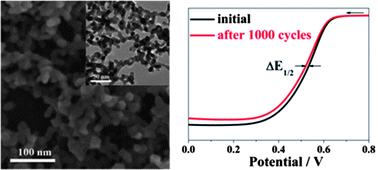One-pot synthesis of three-dimensional platinum nanochain networks as stable and active electrocatalysts for oxygen reduction reactions†
Abstract
Three-dimensional platinum nanochain network (Pt-3NCNW)

* Corresponding authors
a
Jiangsu Key Laboratory of New Power Batteries, College of Chemistry and Materials Science, Nanjing Normal University, 1# Wenyuan Road, Nanjing 210046, PR China
E-mail:
ndchenyu@yahoo.cn
Fax: +86 25-83243286
Tel: +86 25-85891651
Three-dimensional platinum nanochain network (Pt-3NCNW)

 Please wait while we load your content...
Something went wrong. Try again?
Please wait while we load your content...
Something went wrong. Try again?
J. Xu, G. Fu, Y. Tang, Y. Zhou, Y. Chen and T. Lu, J. Mater. Chem., 2012, 22, 13585 DOI: 10.1039/C2JM32012F
To request permission to reproduce material from this article, please go to the Copyright Clearance Center request page.
If you are an author contributing to an RSC publication, you do not need to request permission provided correct acknowledgement is given.
If you are the author of this article, you do not need to request permission to reproduce figures and diagrams provided correct acknowledgement is given. If you want to reproduce the whole article in a third-party publication (excluding your thesis/dissertation for which permission is not required) please go to the Copyright Clearance Center request page.
Read more about how to correctly acknowledge RSC content.
 Fetching data from CrossRef.
Fetching data from CrossRef.
This may take some time to load.
Loading related content
